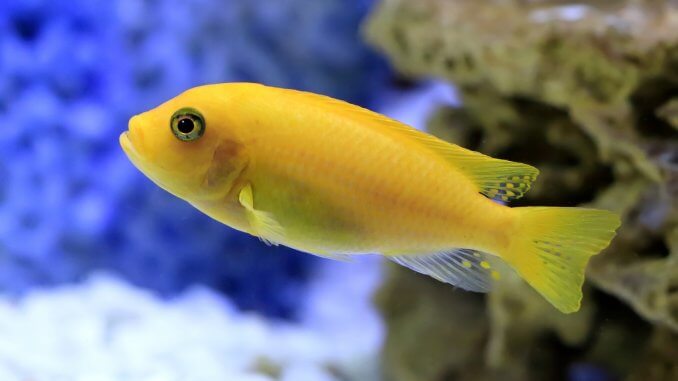
Cichlids are some of the most colorful fish in the fishkeeping world, which unsurprisingly makes them some of the most popular too.
These fish can be found all around the world, so they’re a really diverse group. There is a species to suit everyone, and each species has a different pattern and color scheme.
Cichlids can be difficult to look after due to their aggressive nature, which can be unexpected for someone buying their first one. This shouldn’t put you off though, as cichlids are social creatures that can easily be kept by someone who knows how to care for them.
This article will cover everything you need to know about cichlids, including their care, habitat, and compatibility. We’ll also discuss some of the most popular species.
TABLE OF CONTENTS
Cichlid Facts & Overview
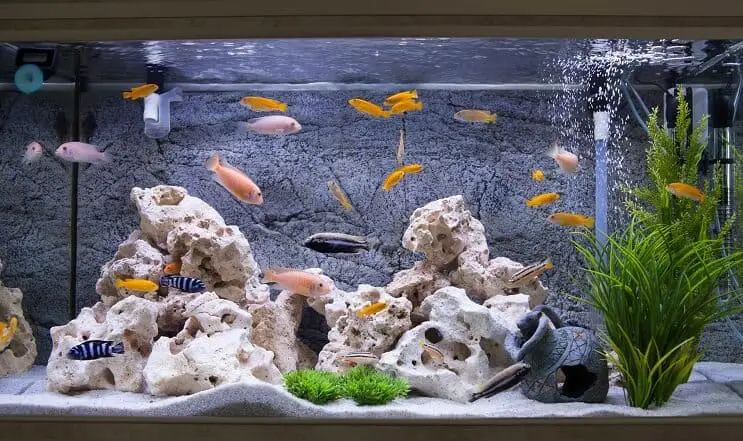
| Category | Rating |
| Care Level: | Intermediate |
| Temperament: | Aggressive |
| Color: | Various |
| Lifespan: | Up to 20 years (species dependent) |
| Size: | 3–15 inches |
| Diet: | Species dependent |
| Family: | Cichlidae |
| Minimum Tank Size: | 30 gallons |
| Tank Setup: | Freshwater: rocks and caves |
| Compatibility: | Species dependent |
Cichlids are a group of freshwater fish from the Cichlidae family. They’re one of the most diverse vertebrate families with over 1600 species, a number that’s always rising.
Nowadays they can be found in most tropical areas of the world, but aquarium species are usually from Africa or South America, with a few from Asia and Europe.
African varieties tend to be from one of Africa’s three great lakes: Lake Malawi, Lake Victoria, or Lake Tanganyika. These lakes contain more species of cichlids than anywhere in the world.
The Amazon River is home to many South American cichlids, but some species can be found in slow-moving streams across the continent, and even up into Central America.
In South American rainforests, there is a group of small fish, usually called dwarf cichlids. These cichlids are only about 0.5 inches long.
Due to their bright colors, distinct patterns, and active lifestyles, cichlids are popular for home aquariums. They are also very hardy, which makes them much easier to keep than other popular fish.
However, the decision to keep these beautiful creatures also comes with a catch – most cichlids are very aggressive and territorial, and will often target and kill any weak fish you add to your tank. You need to be extra careful when choosing tank conditions and mates for your cichlid.
These fish are best suited for a more experienced fish keeper, as their aggression makes them more of a challenge to look after compared to other tropical fish.
Since there are so many species available, this article will cover some of the most popular examples from around the world.
Typical Behavior
Cichlids are notorious for their aggressive nature, and it is the biggest problem that most people have with them. Cichlids will claim a territory and attack any fish that swim too close.
While dealing with their aggression is a challenge, you just need to know how to properly handle them. If you set up a suitable tank and choose the right tank mates for your cichlids, you won’t have any problems.
If you see two males locking lips, then they are in the middle of a fight. This is probably because of a territory dispute or a display to show off for females. When you see a male and a female locking lips, it’s likely part of a courting ritual.
You may also notice that much of their time is spent scavenging for food, which involves digging through the substrate. When digging, they might knock over decorations that aren’t stacked properly. You should make sure any decorations are secured in the substrate so that fish don’t get trapped.
Adults aren’t typically shoaling fish in the aquarium, but they will pair up when mating.
Even though they don’t shoal, cichlids are still very active and social swimmers. Some would even say they are too good at swimming, as they have been known to jump out of the water! Make sure your tank has a tight-fitting lid.
You might spot them rubbing themselves on surfaces. Most of the time this will be due to a parasite such as Ich or Velvet, but sometimes it can be a breeding behavior.
Some species rub themselves onto surfaces as a way to get clean before laying their eggs. Research the species you have to see which behavior is most likely being displayed.
Appearance and Types of Cichlids
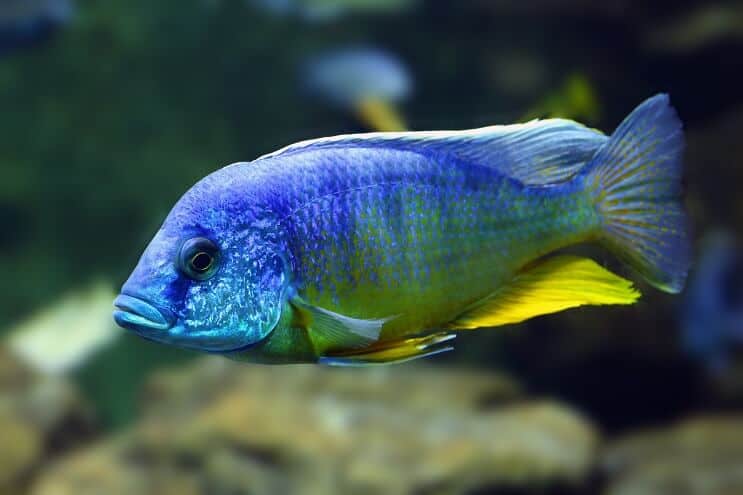
Most of the 1600 species have a unique appearance. Below we have listed and detailed the most popular genus’ and species in the Cichlidae family.
Lake Malawi Cichlids
This is the first of three great African lakes which offer some of the most popular species for home aquariums. They are split into three main groups, Haps, Peacocks, and Mbunas.
Haplochromis, also known as Haps, are typically piscivorous. They have long torpedo-like bodies and are typically silver or grey as young, and the males become bright as they reach sexual maturity.
Peacocks belong to the genus Aulonocara and are very brightly colored, as their name suggests. Males display most of the color and can get to 4-6 inches long. The shape of their body varies and can be used to identify between species.
Mbuna have some of the most dazzling patterns. Some of the most famous and sought after are the bumblebee cichlid and the zebra cichlid (Pseudotropheus zebra), which has an iconic striped design. They are rock-dwelling species that grow to around 5 inches when mature.
Lake Victoria Cichlids
While Lake Victoria used to contain over 500 species, this number is on the decline because of the introduction of the Nile perch.
Species here are moderately sized at around 3-7 inches. Their shape varies from the sleek, bullet-shaped ruby green cichlid, to the Kenya gold cichlid which has large, colorful fins.
Lake Tanganyika Cichlids
Lake Tanganyika is the last great African lake that we will discuss. This is home to the largest species, Boulengerochromis microlepis(36 inches). Not every species from this lake grows so big though, some are as small as 1 inch (such asa femaleNeolamprologus multifasciatus).
Just like from the other two lakes, fish from Lake Tanganyika are very colorful and come in many different shapes and sizes.
Angelfish (Pterophyllum)
Although angelfish are a small genus, they are one of the most famous in South America.
Its long fins make it much taller than most fish, reaching up to 10 inches in height. These fins mean that angelfish need a tall tank to fit comfortably into an aquarium. Colors can vary from white to orange, some display black vertical stripes across its body.
Convict Cichlids (Amatitlania nigrofasciata)
Convict cichlids have black and white stripes across their bodies, hence the other common name they get, zebra cichlids. These South American fish live in large rivers or streams. Males can grow up to 6 inches and display large dorsal and anal fins along their length.
Midas Cichlids (Amphilophus citrinellus)
You can find these fish in a few different colors because of captivity breeding, but the most common is bright orange. An adult will be around 15 inches in size with a hump on their head.
Habitat and Tank Conditions
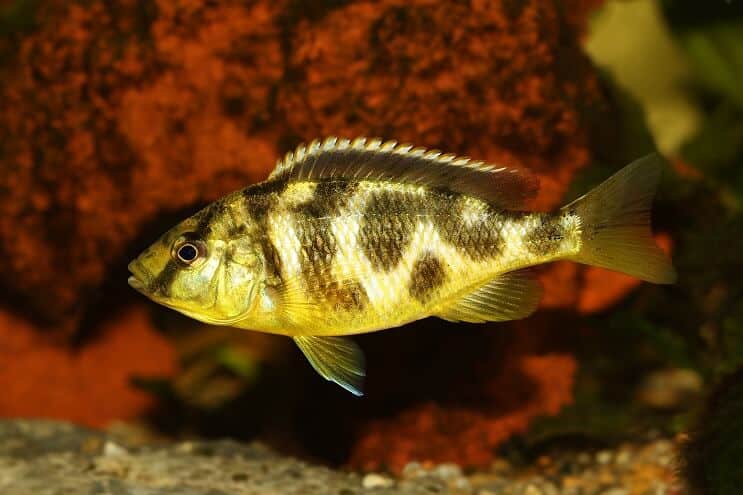
To make the perfect cichlid tank, you need to think about where your new fish come from. Although they all share similar habitats there are a few differences between them. One example is the flow of water. African species from the great lakes don’t need as much water movement as those from rivers in South America.
It’s always best to research the species you want; this will give you a better idea of what their preferences are going to be. If they’re happy then they’re more likely to stay healthy.
A soft substrate at the bottom of the tank is important because of their digging behaviors. Sand would let your fish dig all day without getting scratched by any sharp stones.
Caves and crevices are needed throughout the tank too. These let your fish claim territory and escape when other fish show aggression. For rock-dwelling fish like the Mbunas, caves are a must. If you’re piling up rocks to create your caves, then you need to be careful that they won’t collapse. Aquarium-safe glue can be used to hold them together when fish start digging around.
Adding plants to your aquarium is always a risk. Most species will eat or uproot them when scavenging for food. You have the choice of either not adding plants or choosing a hardy species that might survive.
Java fern and Amazon swords are good options if you do want plants. Not all species (such as some peacocks) will eat plants though.
As far as equipment goes, you don’t need anything special. You only need a filter that can process all of the water in the tank 3-5 times in an hour and a suitable heater. Some people like to add air or water pumps to create water movement, but the filter outlet usually produces a strong enough flow in smaller tanks.
Both African and South American varieties will be healthy in temperatures between 75°F and 85°F, but they have different pH preferences.
African lakes have an unusual 7.8-8.6 pH range, but South American species are used to a more acidic 6.0-7.5.
A similar trend is shown with water hardness. Species from Africa like hard water (4-6 dH), but South American species need softer water (<2 dH).
Make sure to check the preferences of the species you want, as one could be different from another, even if they’re from the same continent.
The bigger the tank you have, the more fish you can keep, and the larger the species can be. 30 gallons is enough space for a small group of most species, but not all. If the fish grow over 7 inches, a 50-gallon tank would be safest. A single midas cichlid needs roughly 60 gallons of water. If you are unsure what size tank to get, a bigger tank is always better.
Once your tank is set up, you need to keep it clean by performing water changes every 1-2 weeks.
Tank Mates
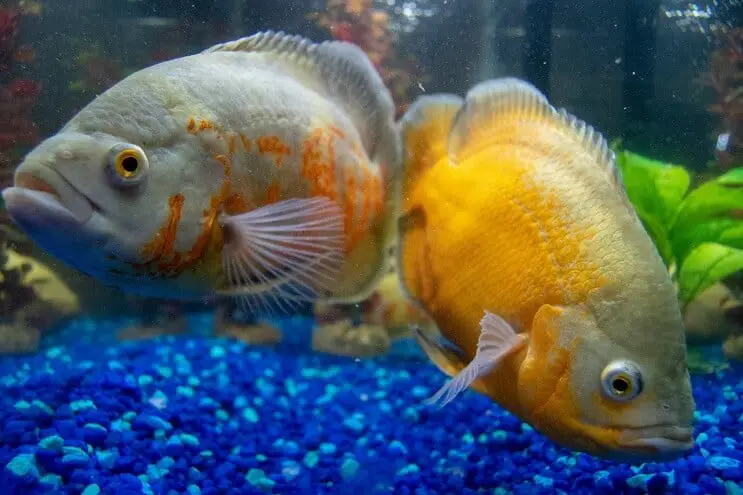
The aggressive nature of this group of fish makes it hard for them to mix with other fish without fighting. It’s common to keep one species on its own, but you’re not limited to this.
To add fish without starting fights, the new species should occupy a different area of the tank. For example, bottom-dwelling fish should be fine with free-swimming cichlids. Any fish you add need to be of a similar size to your cichlids, and they need to be aggressive themselves. This means that they can defend themselves.
Clown loaches and red tail sharks are some good bottom-dwelling fish, while leopard bushfish are aggressive free-swimming fish for species of a similar size (7 inches).
Smaller species (3-4 inches) could even be kept with giant danios (tare large enough that they wouldn’t be seen as a meal).
African catfish pair up well with African varieties because they are fast, large, and aggressive. The bristlenose pleco (Ancistrus) is a good example from South America and it is a good algae eater.
If you add small fish (such as tetras), they will be treated as a snack, small and peaceful fish are an absolute no go as tank mates.
If a tank is big enough then more than one type of species could be kept together, but it will be risky. If you are keeping multiple species don’t mix African with South American. They have evolved on two different continents; their immune systems are very different. When kept together, one species can make the other sick.
Species that work best together are small fish from the same area. Smaller species are usually less aggressive, and if they are from the same area then they can tolerate the same conditions.
Advanced fish keepers sometimes use a technique called crowding, used to reduce aggression. It involves overstocking the tank so that aggressive fish lose their victim.
Crowding lets you keep more individuals without increasing fights. This is shown in Africa’s great lakes where you find 10-18 fish per square meter.
Beginners shouldn’t attempt this straight away; this amount of fish will often lead to mistakes.
Care
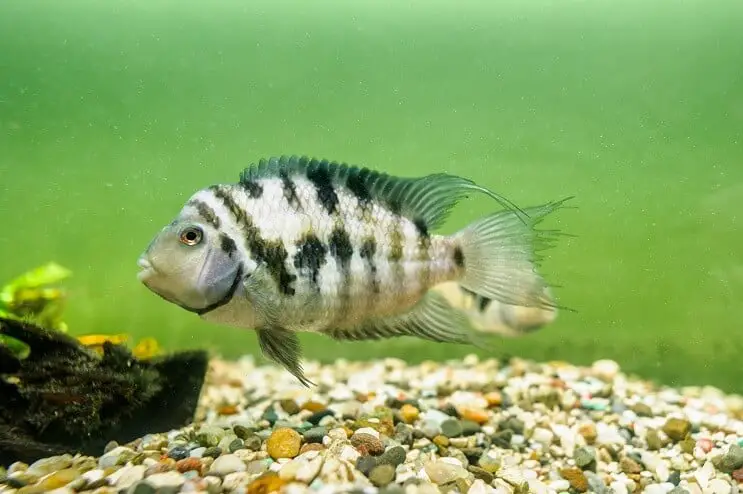
No matter what fish you’re looking after, you’ll likely come across a disease or two at some point. There are lots of species so there are lots of diseases that they could be affected by.
Malawi bloat is probably the most common disease that affects African varieties in the aquarium. A fish will begin to lose its appetite and its abdomen will begin to swell. The main cause is overfeeding.
Parasites can also be a problem. White spot disease (ich) and velvet disease are both caused by parasites; they eventually lead to respiratory problems because they damage the gills. Gill flukes are caused by a flatworm parasite which covers the gills in slime.
If you feed them regularly, watch out for aggression and perform water changes every 1-2 weeks to keep nitrates low, your fish should stay healthy and shouldn’t encounter many diseases.
Diet
Their diet in the wild is a lot more varied compared to in an aquarium. Naturally, different species eat different foods, some eat meat and some eat plants. In captivity most species aren’t fussy and will happily eat a mixture of both.
They should all accept both store bought and homemade fish foods. Flake foods can make up the main part of their diet, you can then add in natural preferences as an occasional treat.
Bottom-dwelling fish will appreciate wafer or pellet food because it sits on the substrate for when they scavenge and is more likely to slip past any fish swimming above.
Peacocks and convicts are insectivores, so you can add in live/frozen insects for them. Mbuna are mainly herbivorous so you can give them algae wafers and plant matter.
The better you know the fish you’re looking after, the easier it is to plan a healthy diet.
Another option is to add raw vegetables from your kitchen into the tank; this is a good way to switch up the diet of an herbivorous feeder.
If your fish are left hungry then they’ll become aggressive. You can feed them a couple of times a day, but only an amount that will be completely eaten after 2-3 minutes.
Even if they’re not, healthy fish will always appear hungry. This makes it easy to overfeed them, leading to health problems. If your fish don’t seem interested in feeding, they are either ill or being overfed.
Breeding
If kept in a healthy environment, your fish should be able to breed without much intervention.
The process starts off with an impressive courting display. This will show off their colors and it’s really amazing to watch.
All species lay eggs, but the way they do it can vary. Some species are mouthbrooders and others lay their eggs on the sediment.
Mouthbrooders hold fertilized eggs in their mouths until they hatch after 21 days or so. This is a common breeding method for African types including Peacocks, Mbunas and Haps.
South American varieties are more likely to lay their eggs on a surface and guard them until they hatch. Aggression will be at its highest during this time to protect their young.
Females will look after the young for a week or two before going off to breed again, leaving the young to fend for themselves.
The young can take a while to mature, but it’s different for every fish. Some might gain their colors after 3 months and be able to breed within a year, others might take double this. If you are looking to keep the young to raise them, it’s best to use a breeding tank to separate them from the parents (they will gradually start to see them as a meal).
The young will need their own diet, with smaller pieces of food than the adults, until they grow larger.
For the best odds at successful breeding, try to keep the aquarium environment the same. Don’t move decorations or add fish, and make sure that the water parameters are consistent. They will breed when they are comfortable and settled.
If you want to encourage breeding you should keep one male to 4-5 females.
They can also cross-breed. This is where individuals from different species will mate.
Should You Get a Cichlid?
Keeping cichlids is not an easy task. Their size and aggression make them more difficult to look after compared to other tropical fish.
Those who have done their research and have time to devote to fishkeeping will be able to maintain a healthy tank and keep some of the most rewarding fish available.
A cichlid tank is one of the most interesting tanks you can have. Cichlids have bright colors and patterns. They are also active and social, and display some unique behaviors, especially when mating.
Those who keep any of these species won’t be disappointed.
Frequently Asked Questions About Cichlids
- Will cichlids eat Java moss?
- Can I put live plants in my cichlid tank?
- How do you tell if your cichlids are happy?
- What is the meanest cichlid?
- How many cichlids can you put in a 55-gallon aquarium?
- Do cichlids prefer sand or gravel?
- What is the easiest cichlid to care for?
- What is normal cichlid behavior?
- Can cichlids live with guppies?
- What do cichlids need in a tank?
- What is the most peaceful cichlid?
- Are cichlids good for beginners?
- Are cichlid fish aggressive?
- Are cichlids hard to keep?
- What is special about cichlids?
- Can cichlids live with other fish?

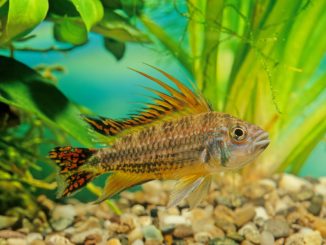
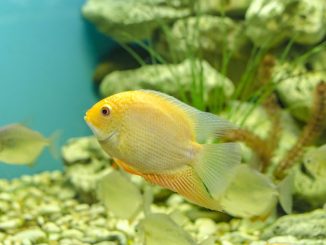
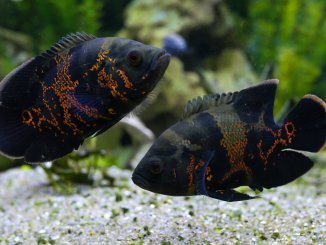
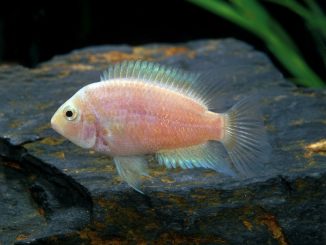
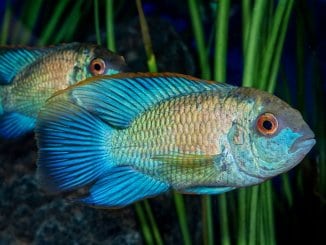
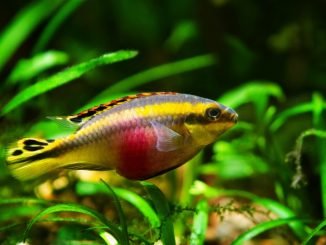
I have been a freshwater fish keeper for 40 years. Starting with a gold fish pond in my garden. When I moved to a 55 plus condominium, 13 years ago, I started a fresh water aquarium with aBeta and then continuing up to 7 tanks of various sizes and fish. I now have 1 angel fish for 4 years in a 20 gallon tall Hex tank, 1 African leaf fish, 2 Betas, assorted Tetras (neons, skirt tetras etc.), guppies etc,
For my 80th birthday got a 55 gallon tank and decided to raise African cichlids. i now have 6 cichlids total. I angel fish, I’ve had for 4 years in a 20 gallon tall hex tank . My recently started 55 gallon tank ha 5 cichlids, that I was told at the LFS were all South African, I think are all Mbunas. I am very sure none are peacocks.
I have now entered a more advanced fish keeping and would appreciate any advice in keeping these new fish healthy. Your internet site has been very helpful.
Thank you
Jo-Ann stokes
First thanks for your web site,
My question is what is they water parameters for frontosa
every where I read they ph is different gh different kh different
what is they proper water
again thanks for your website